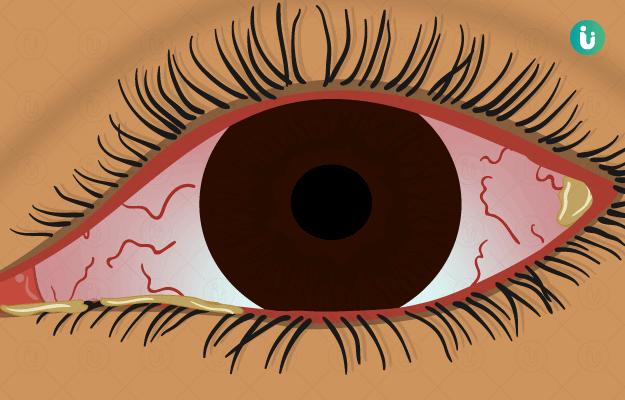What is eye discharge?
Our eyes keep on producing some amount of mucus constantly for protection and normal functioning. This mucous is flushed out with every blink in a continuous thin film of tears. As an individual does not blink during sleep, this mucus collects and crusts at the corners of the eyes and along the eyelashes. Although it may feel unpleasant at times, a small amount of eye discharge (clear or whitish) is normal. However, excess production or discoloured (green or yellow) eye discharge, it is considered abnormal.
What are its main associated signs and symptoms?
Signs and symptoms associated with eye discharge include:
- Pus or discharge (which could be yellow or green) from the eyes
- Dried pus on the eyelids and eyelashes
- On waking up, an individual may experience sticky eyelashes which are matted together
- Red or pink discolouration of the white part of the eyes (may or may not be present) (Read more: Red eyes causes)
- Puffiness of the eyelids is commonly seen
In severe cases, the following alarming symptoms might be seen:
- Fever more than 104°F
- Severe pain in the eyes, with swollen or red eyelids
- Blurring of vision (Read more: Blurred vision treatment)
What are its main causes?
The main causes of eye discharge include:
- Normal discharge. A small amount of cream-coloured dried mucus present only at the corner of the eye, often caused by an irritant that got in the eye from dirty hands
- Blocked tear duct
- Conjunctivitis – bacterial, allergic, or viral
- Keratitis
- Blepharitis
- Eye injury
- Foreign body in the eyes
- Cellulitis of eyelid, which could be serious
How is it diagnosed and treated?
Initially, your physician will take a detailed history of the symptoms and will meticulously check your eyes.
Treatment of eye discharge depends on its causative factor. The various measures to treat it include:
- Warm water and wet cotton balls should be used to clean normal discharge or pus from the eyes. After cleaning, the cotton should be disposed carefully, and hands should be washed thoroughly to avoid reinfection.
- Avoid touching the face or eyelids and the use of eye makeup.
- Antibiotic or antiviral eye drops are prescribed in cases where an infection is a cause.
- An individual should avoid wearing contact lenses and use spectacles when there is an abnormal or excessive eye discharge.

 Doctors for Eye Discharge
Doctors for Eye Discharge  OTC Medicines for Eye Discharge
OTC Medicines for Eye Discharge



















